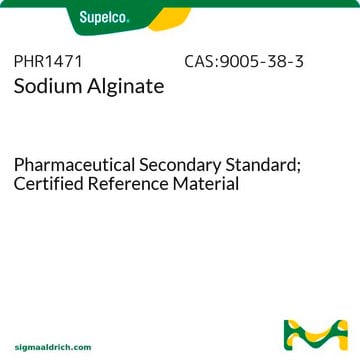71238
Alginic acid sodium salt from brown algae
BioReagent, suitable for immobilization of micro-organisms
Synonym(s):
Algin, Sodium alginate
About This Item
Recommended Products
biological source
algae (brown)
Quality Level
product line
BioReagent
form
powder
ign. residue
≤30%
loss
≤15% loss on drying
color
white to light beige
pH
6.0-8.0 (10 mg/mL in H2O)
suitability
in accordance for gelation test
suitable for immobilization of micro-organisms
storage temp.
room temp
SMILES string
[Na+].[O-]C(=O)C1O[C@H]([C@H]([C@H]([C@@H]1O)O)O)O
InChI
1S/C6H10O7.Na/c7-1-2(8)4(5(10)11)13-6(12)3(1)9;/h1-4,6-9,12H,(H,10,11);/q;+1/p-1/t1-,2-,3-,4?,6+;/m0./s1
InChI key
MSXHSNHNTORCAW-MPGIDXPLSA-M
Looking for similar products? Visit Product Comparison Guide
Application
Other Notes
Storage Class
11 - Combustible Solids
wgk_germany
WGK 1
flash_point_f
Not applicable
flash_point_c
Not applicable
ppe
Eyeshields, Gloves, type N95 (US)
Choose from one of the most recent versions:
Already Own This Product?
Find documentation for the products that you have recently purchased in the Document Library.
Our team of scientists has experience in all areas of research including Life Science, Material Science, Chemical Synthesis, Chromatography, Analytical and many others.
Contact Technical Service






